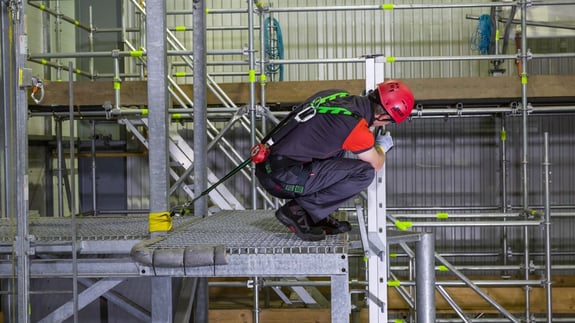
Fall protection is always a popular topic in the safety world and it’s no wonder why; falls are the leading cause of death in the construction industry. Statistics from as recent as 2014 show that nearly 40% of all construction fatalities are due to falls. The importance of training is more than staying in compliance with OSHA regulation 1926.503, it’s about saving lives.
Just a few years ago, ANSI released a new standard Z359.14 that addresses leading and sharp edge application for self-retracting devices on personal fall arrest systems.
- A leading edge refers to the edge of a floor, roof or other walking/working surface that is considered to be an unprotected side and edge and a worker risks falling.
Basically. the new standard references new testing requirements and some pretty significant changes to the design. Another important feature of the standard is the requirement that manufacturers must provide new information in their instruction manuals and on the products themselves.
It wouldn't hurt to take a look at 29 CFR 1910 and review the requirements for providing fall protection, it's chock full of additions to the existing requirements, including those to walking/working surfaces. In fact, some new requirements went into effect January 17, 2017.
According to 29 CFR 1926.503, employers must provide a fall protection training program to workers who may be exposed to fall hazards.
- Employees must be trained to identify and understand the hazards
- Have a competent training instructor come on site to help workers better understand how and when to use certain fall arrest systems
- Employees must be able to use and operate controlled access zones, guardrails, personal fall arrest, safety net, warning line and safety monitoring systems
- Workers must understand what each person’s role is in the safety monitoring program
- Workers must understand the limitations of mechanical equipment
- Workers must understand the correct procedures for equipment and material handling as well as storage and erection of overhead protection
- Workers must understand OSHA’s fall protection requirements
Lifelines respond much differently in leading edge or sharp edge applications. In the event of a fall in these situations there is greater likelihood for a pendulum effect that could result in cutting fraying and compromising the integrity of the lifeline.
Here are some examples of products that are compliant with leading edge standard updates:
-
Nano-Lok™ Edge Self-Retracting Lifeline: Specifically designed for foot level tie-off, when anchoring at the user’s feet is the only option. Requires fall clearances as low as 16. Integrated, backpack-style energy absorber works with connector to limit forces to protect against sharp edges. Meets ANSI Z359.14.
- HALO Cable SRL-LE: SRL designed specifically for leading edge (LE) work. Includes integrated shock absorbing component that helps refocus forces away from the portion of the cable that comes into contact with the edge. Features galvanized steel cable and steel snap hook connector.
- TurboLite™ MAX: Spectra® webbing lifeline with a variety of connector options. Designed for use in smooth edge applications with radius = 0.060" (1.5 mm). High-impact nylon housing and abrasion-resistant webbing with a compact and lightweight design. Includes integral shock absorber to reduce force on the worker if a fall were to occur over an edge. Can be used for foot-level tie-off or anchored overhead for workers up to 420 lbs. Integral swivel design prevents lifeline from twisting and enables more natural movement of the worker. Meets Leading Edge requirements.
Document, document, document
The road to hell is paved with good intentions. No matter what fall protection systems you have in place, if you don’t have follow through, you have nothing. Make sure you have a written certification record for the training and retraining provided to each worker. And leading edge work has its own set of unique hazards that must be addressed before work begins.
Spending time upfront figuring out what protection you need for the job will only save your sanity later on. If you value piece of mind and your sanity, make sure you have a competent person perform a safety assessment. All these little details add up to mean one thing. The only way you can know your team is protected is through training and education. Make sure everyone on your crew knows what PPE is needed for each application and make sure they know how to use it.
Safety: It's Your Life, It's Our Business








